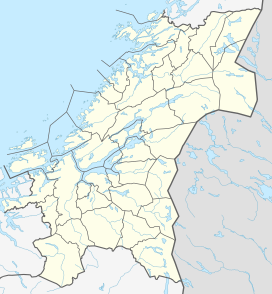| Gauldalen | |
|---|---|
| Gauldal | |
 View of the Gaula River at Kotsøy in Midtre Gauldal | |
| Length | 145 kilometres (90 mi) |
| Geology | |
| Type | River valley |
| Geography | |
| Location | Trøndelag, Norway |
| Coordinates | 62°58′05″N 10°58′03″E / 62.9681°N 10.9675°E |
| Rivers | Gaula |
Gauldal or Gauldalen (English: Gaula River valley) is a valley and traditional district in Trøndelag county, Norway. The river Gaula runs through the 145-kilometre (90 mi) long valley from the Røros mountains near the lake Aursunden to the Trondheimsfjorden. The narrow valley runs northwards from Røros to the Haltdalen area, where it widens some, turns and heads generally to the west to the village of Støren. At Støren it turns again and heads north through what is now a wide, agricultural valley until it reaches the sea just south of the city of Trondheim. The Rørosbanen and Dovrebanen railway lines follow the Gauldalen valley on their way to Trondheim. The European route E6 highway and the Norwegian County Road 30 also follow the valley.[1]
The traditional district of Gauldal includes the municipalities of Holtålen, Midtre Gauldal, and Melhus. The municipality of Røros is often (traditionally) counted as a part of the district, even though it lies outside the actual Gaula river valley.[1]
YouTube Encyclopedic
-
1/1Views:2 399
-
Weapons of Vietnam-Part 3.wmv
Transcription
History

In September 1345, there was a landslide just north of the village of Støren. The landslide was at a very narrow point in the valley and possibly 45,000,000 cubic metres (59,000,000 cu yd) of gravel and dirt from the mountainside fell and blocked the valley and Gaula river below creating a dam on the river that was possibly 30 to 40 metres (98 to 131 ft) high. This tremendous landslide then created a quickly rising lake that began to flood the valley up to 15 kilometres (9.3 mi) upstream from the dam. This newly formed lake flooded and destroyed 25 upstream farms in the narrow valley. The vast amount of water building up behind the earthen dam from the landslide did not hold long and, when it burst, the water rushed though the dam and caused a major flood downstream, killing about 500 people and destroying another 25 farms as well as several churches. The downstream flash flood continued to just past the village of Melhus, not far from the mouth of the river Gaula. This was one of the worst natural disasters ever in Norway.[2]
Media gallery
-
Gauldalen valley
-
Gauldalen valley
-
Gauldalen valley
-
Historic farm in the valley
-
Gaula river
-
Gaula river
-
Støren village
-
Støren Church
-
Melhus village
References
- ^ a b Haugen, Morten, ed. (2017-12-12). "Gauldalen". Store norske leksikon (in Norwegian). Kunnskapsforlaget. Retrieved 2018-01-20.
- ^ Rokoengen, Kåre; Jespersen, Martin Nørman; Kleiv, Rolf Arne; Sæterbø, Einar (2001). "The 1345 slide and flood disaster in the Gauldalen valley, Mid-Norway". Norsk Geografisk Tidsskrift - Norwegian Journal of Geography. 55 (2). doi:10.1080/00291950121138.











